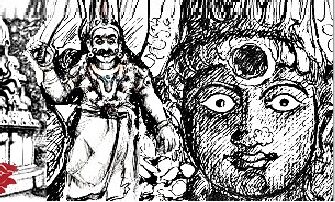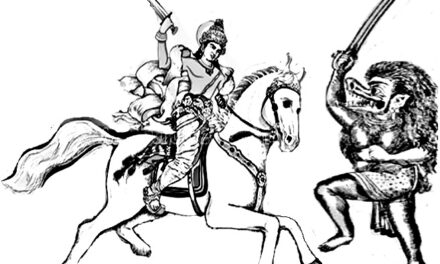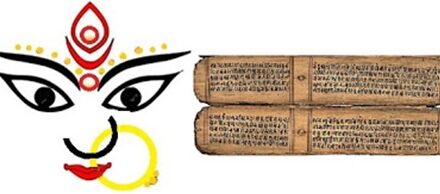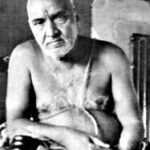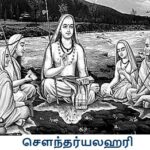
KULA DEVATHA OR TUTELARY/FAMILY DEITIES:
ORIGIN AND CONCEPT
-Santhipriya-
201.How does the punishment of divines leave effect and defaulters punished? Let us continue with the same group. Once the prayers of group ‘A’ is answered, then the resultant boon gets converted into the shape of negative energy rays and reach the person or group concerned say group ‘B,’ (who were engaged in the act of wrongful acts) and intrude into them activating harmful effects mentally thereby taking away their happiness and health. To allow the punishments to take place the Kuladevatha of group ‘B’ will remain inactive. This results in endless struggle and mental agony to the ‘B’ group destabilizing them in many ways.
202. At the same time the Kula Devatha or Tutelary/Family deity are also empowered to condone the punishment at later stage when the punished group ‘B’ continuously and sincerely prayed (without knowing the reasons for their sudden suffering) to their Kula Devatha or Tutelary/Family deity seeking relief from their problems. Upon satisfied with their sincere prayers, the Kula Devatha or Tutelary/Family deity could revoke the punishment given by the other divine, after due consultation with the divine which meted out the punishment. There are many such hidden norms and riders that curb the unilateral decisions of divines against fellow divine acts which remains beyond the scope of humans to clarify or understand.
203. In order to maintain the dignity and honour of the divines, Brahma has incorporated several such norms for the functioning of divines as he was aware that the entire fleet of Kula Devatha or Tutelary/Family deity are the same energy rays of ‘Supreme’ and therefore insulting or degrading the powers of the Kula Devatha or Tutelary/Family deity or infringing into their domain without due care would be tantamount to insulting their manifestation and the purpose for which they had been sent to the vast land.
204. All the above will illustrate that similar to the humans, the divines are also covered by certain norms in exercising their power and authority. All these have been done to show to the universe that the rule of law and justice is not limited to the mankind alone, but also applicable to the divines of land- Devaloga.
205. Like present day computer, Brahma would have possessed something similar to meticulously work out details of space where specific sets of divines of various nature, angels or other souls were to manifest. He has to monitor all acts meticulously including death and birth of souls sent by him to earth. He has to monitor the acts of divines etc etc.
206. The Kula Devatha or Tutelary/Family and other divines will go and manifest only in the earmarked spot (spot does not mean a one square feet or square yard in size, but spread over few square meter area). Lord Brahma established this norm so that the deities and divines earmarked to a particular space need not get confused over the spots where they would manifest.
207. After manifesting in the area allotted, the deities ground their divine powers in those spots and get themselves enshrined on the same spot either in a shine or in open spaces in any form as they desire. No norms are stipulated for it and those divines were permitted to choose an appearance and form of their liking and convey the same to the humans either through their dreams or through those in trance to ensure that their statues or idols of worship are accordingly carved out by the people for enshrining in the spot where they get manifested.
208. One clear norm of Brahma was that wherever they manifested, that spot would get fully sanctified, grounded with divine energies of those who manifested there so that those who reach and pray in the spot could get invisible divine energy protective cover that will guard and guide them in many ways in their life.
209. Wherever the deities wanted to settle down as ordered, as said earlier, first they went and hid themselves in some place and informed about their places of hiding in the dream of the locals. After the locals reached the places and dug out the idols, they enshrined it in the same place which later became the shrine where the folks visited and offered prayers and obedience.
210. Thus, they became the local temple for the locals who settled there and in due course of time became the Kula Devatha or Tutelary/Family for those folks who settled in that village. Thus, in each and every village in some manner or the other, the deities who were destined to settle there, got them identified by the locals in some manner or the other and in course of time became Kula Devatha or tutelary/family deities to the locals there.
211. Can a divine who originally manifested in the space earmarked for them, again manifest in another space? This doubt arises because the same deity in the same form and name is found in many other temples spread in different spaces and the pundits in those temples say that one could offer prayers to the same deity in any of the temples where they have been enshrined.
212. Their contention is incorrect and not acceptable as per divine norm. At the same time, the divine norm does not prohibit offering prayers to the same deity in any of the temples spread in different other spaces other than the original place where they had manifested first.
213. Therefore, those who offer prayers to their Kula Devatha or Tutelary/Family in other temples will certainly receive the blessings in the normal manners bestowed to everyone, but the extent of blessing received would be far different than offering the prayers in the main temple.
214. Let us study this by an example. Though many shrines exists for Aiyanar in different villages spread across Tamilnadu, the family of one Sundar worshipped one Aiyanar deity in Namakkal village (shown in blue colour) as their Kuladevatha.
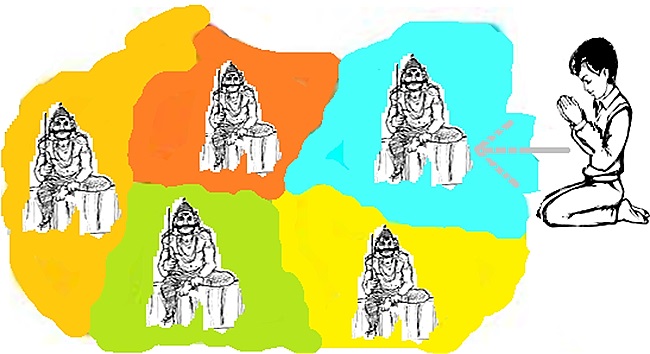
215. The other Aiyanar temples (same image and similar in all other aspects) existed in different other villages and towns (shown in other colours like yellow, orange, green, darkish yellow etc). Assume that the family of Sundar migrated to the dark yellowish shown village and continued to offer worship in the Aiyanar shrine treating it as his Kula Devatha. He completely stopped visiting the original village (Blue in colour) to offer prayers in his Kula Devatha shrine and continued to offer rituals and prayers only to the Aiyanar (in dark yellowish zone), treating the same as his original Kula Devatha (Aiyanar)
216. Will his prayers get accepted by his Kula Devatha and his act endorsed as acceptable? The worshiper will no doubt get blessings of Aiyanar in the dark yellowish zone to the extent of his prayer and rituals, but he will not beget the blessings he will get to the same magnitude or degree from his Kula Devatha -Aiyanar seated in the blueish colored village, nor will the rituals to Kula Devatha be accepted by his Kula Devatha- Aiyanar in bluish colored zone.
217. Sundar’s original Kula Devatha Aiyanar as worshipped by him in his native village (Bluish colored area) will however bless him fully and accept his rituals done to him in any other temples , in any other area, provided he or any of his family members continued to visit the original temple at least once in few years and offered prayers there because the divine power energies of each deities enshrined in different areas are different (divine energies are specific to the deities enshrined in each place). The divine energies specific to them for an area will lay grounded only in the prime temple spot where they had originally manifested. See the imaginary illustration shown below as an example to understand the theory.
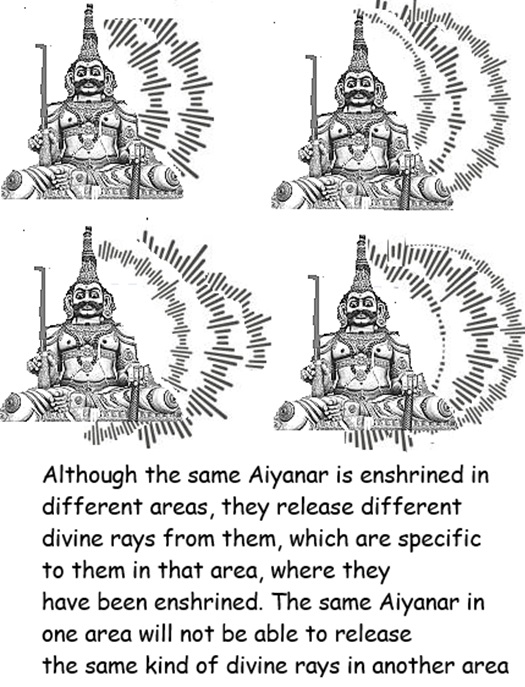
218.Even though the same deities in other temples may have been enshrined with full vedic rites and rituals which also draw and ground divine energies (the rituals in fact are prayers seeking the divine energies to be ground there) of the same divines, the effect would be far different than the direct divine energy one may receive in the original place where they had manifested.
219. The direct divine energies float in the space where the divines had actually manifested and intrude into the bodies of those who go and offer prayers there. This is what is seen as vibration as felt by many of the devotees while praying in the specified place. This does not mean that the family members whose Kula Devatha or Tutelary/Family deity which is shown in blue colored space, will not bless them if they prey to her in another temple as shown in yellow, dark yellow-, green- and orange-colored areas. The Kula Devatha or Tutelary/Family deity will certainly understand their plight and protect and guide them provided the family members visit the main temple at least once or twice in their life span and offer prayers there. Unless this is done, the blessings of the Kula Devatha or Tutelary/Family deity would not be fully received by the devotees.
220.Sometimes the manifested divines (tutelary/family deities or other divines) also intruded into rocks or boulders or other lifeless objects (lifeless in outer appearance though each has their own invisible life in them) or remain in anthills for few years before they get traced or dug out. Once they enter into the rocks or boulders, those structures get infused with their divine energies and get reshaped matching with the appearance. Centuries later those statues when dug out as commanded by them, they were enshrined in a shrine, and worshiped there. Those temples where the original idols had been thus installed had the powerful divine energies floating in the space which could be felt when one visit there. Such powerful divine energies released direct from the divine will not be available in other temples where the same divine idols were installed.
221. Similarly, the anthill, inside which they lived during the period of penance would get filled with their divine energies and sanctified. When temple rose in those places covering the ant hill, the divine energies fill the space inside the temple and throw protective cover to the devotees who visit there. Such forceful divine energies released direct from the divine will not be available in other temples where the same divine idols were installed.
222.Some of the divines never revealed their identity till they completed their penance on earth and after ensuring that the mortal body inside which they stayed during penance get buried below earth or sunk in rivers, the curse reversed divines went back to Deva Loga.
223.Over the years, by acts of nature those bodies became rocks or stones. They were later dug out by the devotees when the same divines revealed to the folks in some manner the spots where their bodies lay buried. Large no of them became Kula Devatha or Tutelary/Family deity centuries later to those who lived in and around there.
224. In the ancient times though many idols of deities were unearthed from several patches of lands in the villages, only a few of them got enshrined in temples, rest laid in open spaces and placed under the trees in the rural areas. They were worshiped by several families for centuries. Over periods of time many of those villages became cities.
225. Some of those village temples slowly grew into magnificent temples during the reign of great kings who wanted to establish bigger temples when they heard of the powers of those deities. Thus, many of the temples which were initially consecrated with the statues and idols unearthed in many ways (Swayambhu or self-manifested idols) either became the Kula Devatha or Tutelary/Family deity to some of descendants of families or remained as temples of commoners. This is also the reason why the temples and Kula Devatha or Tutelary/Family deity as worshiped by most of the family members were still found in remote villages or difficult to reach terrains in forested areas, over the hill, fields, and other remote places.
226. In connection with Village deities and Bhootha worship, I had already written two articles. They may also be referred :
https://santhipriya.com/2015/08/village-deities-and-bhootha-worship-english.htmlin English and https://santhipriya.com/2013/03/%e0%ae%95%e0%ae%bf%e0%ae%b0%e0%ae%be%e0%ae%ae-in Tamil language. Yet to translate into English.
227. We have to understand the basic fact that the exact period or the place where the temples or some kind of worship shrines were constructed has not been conclusively established. But according to the historians, even during the vedic period, there were no shrines or temples, but during AD 1500 to AD 1600, few worship places similar to the temples were discovered in Afghanistan but not in India.
228. Similarly, though existence of temples were discovered in many parts of Asia such as Cambodia, Thailand, Iran, Pakistan, Malaysia, Singapore, and Africa surprisingly no such shrines or temples were seen in parts of India during that period nor idol worship noticed. However, in the much later part of vedic period few shrines where some idols have been worshipped in which Sanskrit mantras have been chanted, were seen deep inside the villages. The idols in them were called guardian deities or Village deities. Most of such places of worship were found in make-shift small huts constructed with mud without top roof or were inside small caves as seen here and there.
229. The floating divine energies in those places where the idols of Kula Devatha or Tutelary/Family deity were dug out and enshrined embrace the body of the devotees like an invisible cover lasting for some period of time (the extent of period for which the said temporary protection lasts is not known) and block the entry of negative energies intruding into them. Perhaps this is the reason why the ancestors have laid out the principle of visiting the Kula Devatha or Tutelary/Family deity temples everyday if they stayed near the temple vicinity or at least visited once a year to retain the protective cover of divine energies on them.
230.Some may wonder when several hundreds of folks have adapted a deity as their Kula Devatha or Tutelary/Family deity, how is it possible for the deity to personally reach each and individual to guide and guard them? The Kula Devatha or Tutelary/Family deity does not liaise with the individuals or the family directly. Every Kula Devatha or Tutelary/Family deity has fleets of invisible ganas to work on their behalf. Kula Devathas too emit from each one of them several lakhs of divine rays to protect those who are under them.
231. Who are those ganas? Several demised forefathers and ancestors of each family members remain as Pithru ganas in Pithru Loga. The moment a family chooses their Kula Devatha or Tutelary/Family deity, immediately the Pithru ganas of those family are called upon from Pithru Loga by the Kula Devatha or Tutelary/Family deity to act as the liasoning ganas between those families and the deity. They in invisible form carry the messages and orders of the Kula Devatha or Tutelary/Family deity to their family lineage.
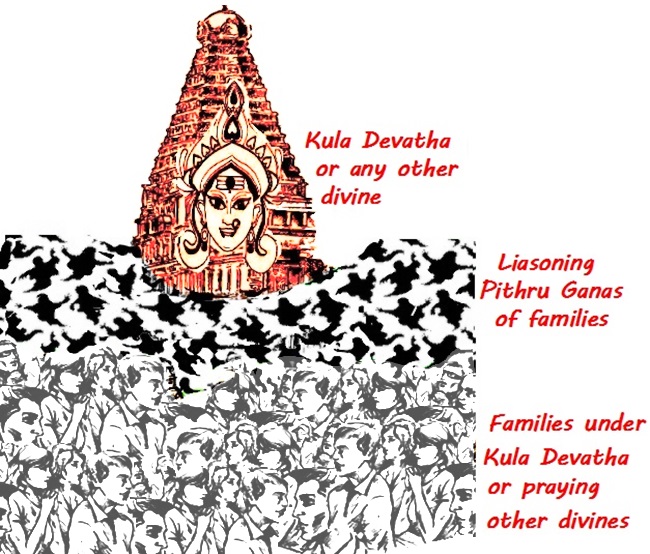
……….continued Serial No 232
References to all these points in last part

